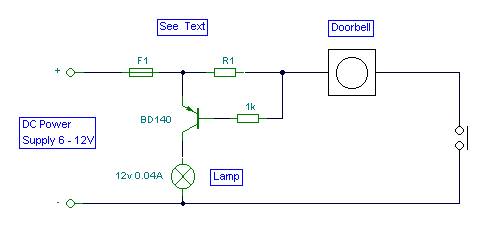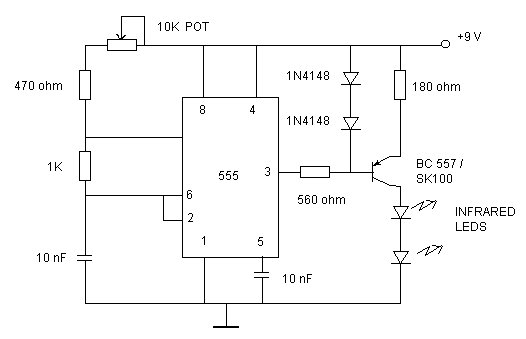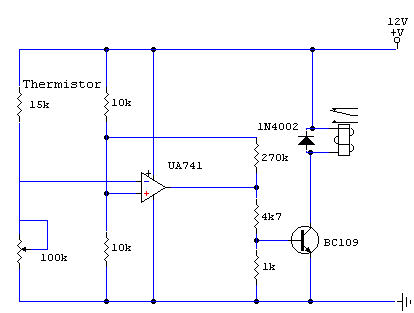
Remote Doorbell Warning Switch circuit

It is easy to miss the sound of a doorbell while watching TV. This circuit addresses the issue by providing a visual indication, such as a lamp or an LED. Connecting a lamp directly in parallel with the doorbell could lead to additional drain on the doorbell's batteries or transformer. Instead, using a series resistor (R1) reduces current flow, extending battery life. The value of R1 is selected to allow a voltage drop of approximately 0.6 to 0.7 volts while still ensuring the doorbell rings. A combination of a 22-ohm resistor in parallel with a 50-ohm resistor was used, allowing the doorbell to function correctly. Previously, an electromechanical counter was employed to register each time the switch was pressed, with a notable increase in "hits" at the doorbell compared to website visits.
This circuit design serves as a practical solution for enhancing doorbell notifications, particularly in environments where auditory signals may be overlooked. The primary components include a doorbell, a visual indicator (lamp or LED), and a series resistor (R1). The resistor plays a crucial role in managing the current flow to ensure the doorbell operates effectively while minimizing the power consumption from the power source.
The circuit configuration involves connecting the visual indicator in parallel with the doorbell. The series resistor R1 is then connected between the power source and the doorbell circuit. The choice of resistor values is critical; the combined resistance of a 22-ohm resistor in parallel with a 50-ohm resistor ensures that the voltage drop across R1 remains within the specified range. This configuration allows sufficient current to flow through the doorbell to activate it while providing enough voltage across the visual indicator for it to illuminate.
In practical applications, the visual indicator can be selected based on user preference, with options ranging from traditional incandescent lamps to energy-efficient LEDs. The latter option is particularly advantageous due to its lower power consumption and longer lifespan, further contributing to the overall efficiency of the circuit.
The use of an electromechanical counter in previous iterations of this design illustrates the potential for additional functionality. By integrating such a counter, users can track the frequency of doorbell activations, which may be beneficial for various applications, including monitoring visitor traffic in residential or commercial settings. Overall, this circuit design not only addresses the need for a visual alert system for doorbells but also offers opportunities for customization and expansion based on user requirements.It is quite easy to miss the sound of a doorbell if you are watching TV, this circuit gets round the problem by providing a visual indication, i. e. a lamp. As an alternative, a LED could also be used. You could just parallel a lamp across the doorbell, but this would mean extra drain from the doorb ell batteries or transformer. Using a series resistor R1 actually reduces current flow, and if run from batteries, will give them a longer life. The value of R1 is chosen so that about 0. 6 to 0. 7 volts is dropped across it, and the doorbell should still ring. I used a combination of a 22 ohm resistor in parallel with a 50 ohm. The doorbell still rang and circuit operated correctly. I used to have an electromechanical counter that registered each time when someone pressed the switch.
in fact, I remember a time when I had more "hits" at my doorbell then at my web site=:) 🔗 External reference
This circuit design serves as a practical solution for enhancing doorbell notifications, particularly in environments where auditory signals may be overlooked. The primary components include a doorbell, a visual indicator (lamp or LED), and a series resistor (R1). The resistor plays a crucial role in managing the current flow to ensure the doorbell operates effectively while minimizing the power consumption from the power source.
The circuit configuration involves connecting the visual indicator in parallel with the doorbell. The series resistor R1 is then connected between the power source and the doorbell circuit. The choice of resistor values is critical; the combined resistance of a 22-ohm resistor in parallel with a 50-ohm resistor ensures that the voltage drop across R1 remains within the specified range. This configuration allows sufficient current to flow through the doorbell to activate it while providing enough voltage across the visual indicator for it to illuminate.
In practical applications, the visual indicator can be selected based on user preference, with options ranging from traditional incandescent lamps to energy-efficient LEDs. The latter option is particularly advantageous due to its lower power consumption and longer lifespan, further contributing to the overall efficiency of the circuit.
The use of an electromechanical counter in previous iterations of this design illustrates the potential for additional functionality. By integrating such a counter, users can track the frequency of doorbell activations, which may be beneficial for various applications, including monitoring visitor traffic in residential or commercial settings. Overall, this circuit design not only addresses the need for a visual alert system for doorbells but also offers opportunities for customization and expansion based on user requirements.It is quite easy to miss the sound of a doorbell if you are watching TV, this circuit gets round the problem by providing a visual indication, i. e. a lamp. As an alternative, a LED could also be used. You could just parallel a lamp across the doorbell, but this would mean extra drain from the doorb ell batteries or transformer. Using a series resistor R1 actually reduces current flow, and if run from batteries, will give them a longer life. The value of R1 is chosen so that about 0. 6 to 0. 7 volts is dropped across it, and the doorbell should still ring. I used a combination of a 22 ohm resistor in parallel with a 50 ohm. The doorbell still rang and circuit operated correctly. I used to have an electromechanical counter that registered each time when someone pressed the switch.
in fact, I remember a time when I had more "hits" at my doorbell then at my web site=:) 🔗 External reference





